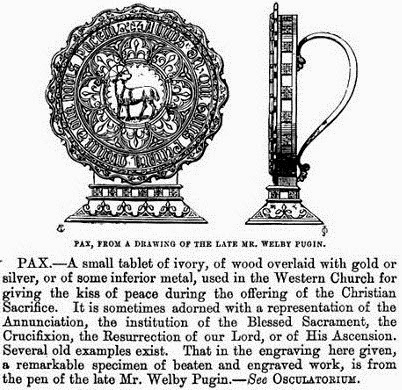 |
| One of the pax-bredes used by Philadelphia's TLM community |
 |
| A missa cantata for St Joseph at the Cathedral-Basilica of Philadelphia's altar of the Assumption |
The origins of the pax-brede, in brief
It seems the pax-brede was originally developed by the medieval Church to give the pax to all members of the congregation in an orderly manner (and, perhaps, to sidestep the tensions caused by persons of the opposite sex who are not married to each other from kissing in church). At a time when Communion was not regularly distributed to the faithful, the pax was almost a substitute for it--everyone would come up to the chancel screen to kiss the pax-brede, much as communicants come up today. Surviving examples from the medieval centuries are often richly detailed. In Shakespeare's Henry V, the king sentences his old pal Bardolph to death "for he hath stolen a pax" from a church in the middle of their invasion of France.
The Una Voce position paper on the kiss of peace explains why this practice declined thus:
"The direct participation of the Faithful in the Pax, for which the Paxbrede was particularly well suited, began to die out in the following centuries in most countries. The liturgical scholar Polycarpus Radó suggests ‘reasons of hygiene’ for this. Another practical reason seems to have been that the practice of passing the Paxbrede among the Faithful according to their social degree led to unedifying disputes over precedence. A modern factor which reduces the time available to present the Paxbrede is the frequency of the Communion of the Faithful during Mass."
The discontinuation due to "reasons of hygiene" is strikingly similar to the argument made in an article in Crisis posted just last month against the modern practice of the Sign of Peace in the Ordinary Form Mass: "A Trinity of Bad Hygiene". And the squabble over precedence amongst the folk of the medieval parish, suggested above, is perfectly illustrated in Eamon Duffy's The Stripping of the Altars:
'In 1494 the wardens of the parish of All Saints, Stanyng, presented Joanna Dyaca for breaking the paxbrede by throwing it on the ground, "because another woman of the parish had kissed it before her." On All Saints Day 1522 Master John Browne of the parish of Theydon-Garnon in Essex, having kissed the pax-brede at the parish Mass, smashed it over the head of Richard Pond, the holy-water clerk who had tendered it to him, "causing streams of blood to run to the ground." Brown was enraged because the pax had first been offered to Francis Hamden and his wife Margery, despite the fact that the previous Sunday he had warned Pond, "Clerke, if thou here after givest not me the pax first I shall breke it on thy hedd."'
Using the pax-brede today
Whatever the reasons for its falling out among the laity, the use of the pax-brede remains a fully licit option in the rubrics of the traditional Latin rite for both sung and even low Mass. Despite having survived even amongst the laity until recent times in Spain and certain Spanish territories, a good case could probably be made against offering the pax-brede to the entire congregation, especially in these times of regular Communion. But for the servers and clergy (and liturgical choir, if present, as well as any princes or lay dignitaries present), the rite has much to recommend it. The pax-brede not only emphasizes a continuity between sung/low Mass and the ceremonies of solemn high Mass; it also reminds us that, however ill-advised the modern practice of the peace in the Ordinary Form is, the concept itself was not invented out of whole cloth as many traditional Catholics mistakenly assume.
 |
| The same pax-brede from the opening of the article, shown from the side |
 |
| Another pax-brede used by the community |


San Antonio Museum of Art ran an exhibition of colonial Spanish art and there were probably some of the most beautiful silver ones I have seen. They seemed more common in Peru.
ReplyDeleteThere is an odd, looking-glass symmetry between medieval squabbles over precedence in kissing the pax-brede and the post-conciliar rage for multiplying lay "ministries" during Mass. There is a grain of liturgical truth and goodness in both (the sign of peace; "active participation"), but each reflects and exaggerates the secular mindset of its age (social hierarchy; egalitarianism). May the latter fade away as the former did.
ReplyDeletehttps://paxventedovenlid3dscreen.blogspot.com/ $20 pax 2 and pax 3 vented oven lid 2.0 made of peek!
ReplyDelete